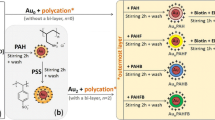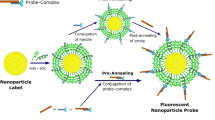Abstract
The interaction between antibodies and ligand-functionalized nanoparticles were exploited in this work by taking advantage of the strong influence that metallic surfaces have on emission of fluorescence. The surface of colloidal gold nanoparticles was functionalized with biotin moieties embedded in a nonfouling matrix of di(ethylene glycol) groups to minimize nonspecific interactions. Antibiotin labeled with fluorophore Alexa™ 488 bound to these particles via specific biomolecular recognition interactions. Upon binding of the labeled antibody to the biotinylated nanoparticles, an immediate decrease in emission of fluorescence was observed. Competitive dissociation of the antibody from the nanoparticles with soluble biotin produced a recovery in the intensity of emission of fluorescence. For large concentrations of the antibody, emission of fluorescence (corrected for dilution and absorption/scattering effects) appeared to increase to levels higher than the intensity of emission of the unbound antibody. This apparent increase is ascribed to a decreased extinction coefficient produced during aggregation of the nanoparticles by the bivalent antibodies. This scheme could have applications in detection of small molecules or could be used to study the interactions of ligand functionalized nanoparticles and proteins.











Similar content being viewed by others
References
Hayat MA (1989) Colloidal Gold: Principles, Methods, and Applications. Academic Press, San Diego, CA
Storhoff JJ, Elghanian R, Mucic RC, Mirkin CA, Letsinger RL (1998) One-pot colorimetric differentiation of polynucleotides with single base imperfections using gold nanoparticle probes. J Am Chem Soc 120:1959–1964
Mirkin CA, Letsinger RL, Mucic RC, Storhoff JJ (1996) A DNA-based method for rationally assembling nanoparticles into macroscopic materials. Nature 382:607–609
Kim JH, Cho JH, Cha GS, Lee CW, Kim HB, Paek CW (2000) Conductimetric membrane strip immunosensor with polyaniline-bound gold colloids as signal generator. Biosens Bioelectron 14:907–915
Velev OD, Kaler EW (1999) In situ assembly of colloidal particles into miniaturized biosensors. Langmuir 15:3693–3698
Li H, Luk YY, Mrksich M (1999) Catalytic asymmetric dihydroxylation by gold colloids functionalized with self-assembled monolayers. Langmuir 15:4957–4959
Collier CP, Vossmeyer T, Heath JR (1998) Nanocrystal superlattices. Annu Rev Phys Chem 49:371–404
Lakowicz JR (2001) Radiative decay engineering. Anal Biochem 298:1–24
Avouris P, Persson BNJ (1984) Excited-states at metal-surfaces and their nonradiative relaxation. J Phys Chem 88:837–848
Persson BNJ, Anderson S (1984) Dynamical processes at surfaces-excitation of electron-hole pairs. Phys Rev B 29:4382–4394
Cnossen G, Drabe KE, Wiersma DA (1993) Fluorescence properties of submonolayers of rhodamine 6g in front of a mirror. J Chem Phys 98:5276–5280
Hao E, Bailey RC, Schatz GC, Hupp JT, Li S (2004) Synthesis and optical properties of “branched” gold nanocrystals. Nano Lett 4:327–330
Hao E, Li S, Bailey RC, Zou S, Schatz GC, Hupp JT (2004) Optical properties of metal nanoshells. J Phys Chem B 108:1224–1229
Kelly KL, Coronado E, Zhao LL, Schatz GC (2003) The optical properties of metal nanoparticles: The influence of size, shape, and dielectric environment. J Phys Chem B 107:668–677
Sokolov K, Chumanov G, Cotton TM (1998) Enhancement of molecular fluorescence near the surface of colloidal metal films. Anal Chem 70:3898–3905
Liebermann T, Knoll W (2000) Surface-plasmon field-enhanced fluorescence spectroscopy. Colloids Surf A 171:115–130
Gryczynski I, Malicka J, Shen Y, Gryczynski Z, Lakowicz JR (2002) Multiphoton excitation of fluorescence near metallic particles: Enhanced and localized excitation. J Phys Chem B 106:2191–2195
Dulkeith E, Morteani AC, Niedereichholz T, Klar TA, Feldmann J, Levi SA, van Veggel FCJM, Reinhoudt DN, Möller M, Gittins DI (2002) Fluorescence quenching of dye molecules near gold nanoparticles: Radiative and nonradiative effects. Phys Rev Lett 89:203002-1 to 203002-4
Maxwell DJ, Taylor JR, Nie S (2002) Self-assembled nanoparticle probes for recognition and detection of biomolecules. J Am Chem Soc 124:9606
Li HX, Rothberg LJ (2004) Colorimetric detection of DNA sequences based on electrostatic interactions with unmodified gold nanoparticles. Proc Natl Acad Sci USA 101:14036–14039
Li HX, Rothberg LJ (2004) DNA sequence detection using selective fluorescence quenching of tagged oligonucleotide probes by gold nanoparticles. Anal Chem 76:5414–5417
Pérez-Luna VH, Yang S, Rabinovich EM, Buranda T, Sklar LA, Hampton PD, López GP (2002) Fluorescence biosensing strategy based on energy transfer between fluorescently labeled receptors and a metallic surface. Biosens Bioelectron 17:71–78
Ulman A (1991) An Introduction to Ultrathin Organic Films: From Langmuir–Blodgett to Self Assembly. Academic Press, Boston, MA
Aslan K, Pérez-Luna VH (2002) Surface modification of colloidal gold by chemisorption of alkanethiols in the presence of a nonionic surfactant. Langmuir 18:6059–6065
Aslan K, Luhrs CC, Pérez-Luna VH (2004) Surface modification of colloidal gold by chemisorption of alkanethiols in the presence of a nonionic surfactant. J Phys Chem B 108:15631–15639
Weisbecker CS, Merritt MG, Whitesides GM (1996) Molecular self-assembly of aliphatic thiols on gold colloids. Langmuir 12:3763–3772
Mayya KS, Patil V, Sastry M (1997) On the stability of carboxylic acid derivatized gold colloidal particles: The role of colloidal solution pH studied by optical absorption spectroscopy. Langmuir 13:3747–3944
Nelson KE, Gamble L, Jung LS, Boeckl MS, Maeemi E, Golledge SL, Sasaki T, Castner DG, Campbell CT, Stayton PS (2001) Surface characterization of mixed self-assembled monolayers designed for streptavidin immobilization. Langmuir 17:2807–2816
Nie SM, Emory SR (1997) Probing single molecules and single nanoparticles by surface-enhanced raman scattering. Sci 275:1102–1106
Hildebrandt P, Stockburger MJ (1984) Surface-enhanced resonance raman-spectroscopy of rhodamine-6G adsorbed on colloidal silver. Phys Chem 88:5935–5944
Aguila A, Murray RW (2000) Monolayer-protected clusters with fluorescent dansyl ligands. Langmuir 16:5949–5954
Acknowledgments
The Armour College of Engineering, the Department of Chemical and Environmental Engineering at IIT, and the Office of Naval Research (award no. N00014-05-1-0914) are gratefully acknowledged for financial support.
Author information
Authors and Affiliations
Corresponding author
Rights and permissions
About this article
Cite this article
Aslan, K., Pérez-Luna, V.H. Nonradiative Interactions between Biotin-Functionalized Gold Nanoparticles and Fluorophore-Labeled Antibiotin. Plasmonics 1, 111–119 (2006). https://doi.org/10.1007/s11468-006-9013-8
Received:
Accepted:
Published:
Issue Date:
DOI: https://doi.org/10.1007/s11468-006-9013-8




